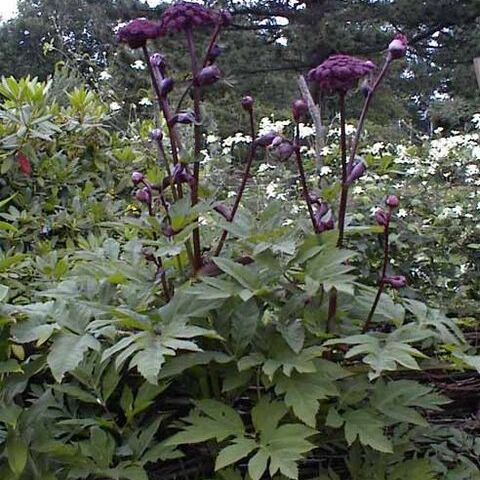Plants perennial, 1–2 m, stout. Root conic, gray brown, 2–5 cm thick. Stem purplish, ribbed. Basal and lower leaves petiolate, petioles 30–45 cm, sheaths broad; blade triangular-ovate in outline, 20–40 × 20–30 cm, 2–3-ternate-pinnate, basal pinnae petiolulate; leaflets oblong-lanceolate, 4–15 × 1.5–5 cm, base decurrent, margin irregularly coarse-toothed, apex acute, slightly scabrous along nerves adaxially. Upper leaves purple-green, sheaths broadly inflated, often bladeless. Umbel purple, subglobose, 5–8 cm across, up to 12 cm in fruit, peduncles, rays and pedicels all hispidulous; peduncles 2–6 cm; bracts 2, saccate, dark purple; rays many, stout, 2–3 cm; bracteoles dark purple, several, ovate-lanceolate; pedicels many, 3–8 mm. Calyx teeth obsolete. Petals dark purple-red, obovate. Anthers purple. Fruit ellipsoid, 5–8 × 3–5 mm; dorsal ribs prominent, lateral ribs broad-winged; vittae 1(–2) in each furrow, 2(–4) on commissure. Fl. Jul–Aug, fr. Aug–Sep. n = 11*.
More
A strong stemmed herb. It takes 2 years to complete its life-cycle. It grows 2 m tall and spreads 1-2 m wide. It forms clumps. The leaves are very large and have a red tint. They are divided 3 times and have teeth along the edge. They are 30-40 cm long. The stems are purple-red. The flower heads are red. These are on stems 1.5 m tall.
Grassy places and open woods in the mountains. In grasses, forests or by stream; at elevations around 1,000 metres.
More
A temperate plant. It suits hardiness zones 5-9. Hobart Botanical Gardens.

